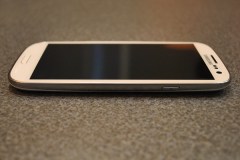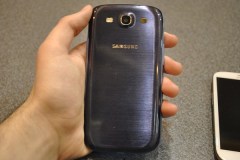Every year, Samsung‘s flagship Galaxy S line has crept up in size, and this year’s Galaxy S III continues the trend with a 4.8-inch display. Not counting the 5.3-inch Galaxy Note, which is more of a phone-tablet hybrid, the Galaxy S III is Samsung’s biggest phone yet.
But why does the crown jewel of Samsung’s smartphone line keep getting bigger? The company says it’s just giving people what they want.
(MORE: The Samsung Galaxy S III: One Huge Display and a Whole Lot of Software)
“People like bigger,” Philip Berne, Samsung’s technical media marketing manager said during a meeting at the CTIA Wireless trade show this week. “We asked them, and they tell us they like big.”
It’s hard to argue with that. Earlier this week, I asked John Young, an AT&T spokesman, why the carrier’s phones keep growing in size. (AT&T launched the HTC One X, with a 4.7-inch display, earlier this week.) Simple, he said: They sell. Young noted that Samsung’s Infuse 4G, which has a 4.5-inch display, was a big seller on AT&T last year, even though at the time it was larger than most other phones on the market. Now, the Infuse just seems normal compared to other handsets.
 I tried to make my case to Samsung’s Berne anyway: Although larger screens are nice to look at–indeed the Galaxy S III’s screen looks gorgeous–they’re tricky to use with one hand, because you must constantly re-position the phone to reach the top edge of the screen and the buttons on the bottom.
I tried to make my case to Samsung’s Berne anyway: Although larger screens are nice to look at–indeed the Galaxy S III’s screen looks gorgeous–they’re tricky to use with one hand, because you must constantly re-position the phone to reach the top edge of the screen and the buttons on the bottom.
Berne countered that Samsung offers a wide range of phone sizes, such as the 4-inch Galaxy S Blaze and the new Samsung Focus 2 Windows Phone. For now, however, users will have to go big if they want the Galaxy III’s other features, such as a 1.4 GHz quad-core Exynos processor, a Siri-like “S-Voice” virtual assistant and a zero-lag camera that can snap a quick succession of shots and automatically choose the best one. Those features will likely trickle down to other Samsung phones with time.
At the moment, Berne said, Samsung isn’t planning to build any phones with 720p resolution displays smaller than 4.65 inches–the size of Samsung’s Galaxy Nexus. Ryan Biden, Samsung’s director of product marketing, said there are technical constraints that prevent the company from making smaller 720p phones anyway.
I suspect that phone makers want the 720p bullet point on their marketing checklists, and it’s easier and cheaper to pack more pixels into a larger display. If technical constraints are at work, I assume we’re at the upper bound of how large 720p smartphones will be, but Samsung wouldn’t say if it’ll keep pushing the envelope.
 In my brief hands-on with the Galaxy S III, I found it to be as smooth as any other high-end handset running Android 4.0, but I didn’t have enough time to draw conclusions about the phone’s software features. I’m still not sure whether S-Voice and Smart Stay, which keeps the screen turned on as long the front-facing camera see your eyes looking down, are actually useful or just neat gimmicks. Samsung’s camera improvements, including a burst shot mode and high dynamic range imaging, do seem beneficial, at least.
In my brief hands-on with the Galaxy S III, I found it to be as smooth as any other high-end handset running Android 4.0, but I didn’t have enough time to draw conclusions about the phone’s software features. I’m still not sure whether S-Voice and Smart Stay, which keeps the screen turned on as long the front-facing camera see your eyes looking down, are actually useful or just neat gimmicks. Samsung’s camera improvements, including a burst shot mode and high dynamic range imaging, do seem beneficial, at least.
In any case, Samsung is turning to these software features to stand out from other Android phones–a move that will likely become a trend among phone makers. Hardware is reaching a point of diminishing returns, so the baseline Android experience is now so fluid and feature-rich that it’s getting harder to tell individual phones apart.
Samsung plans to launch the Galaxy S III in Europe at the end of May. It’s coming to the United States this summer, but so far no U.S. carriers have said whether they’ll offer it.

